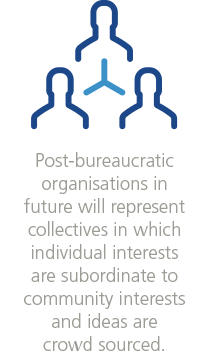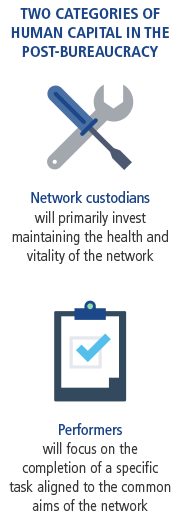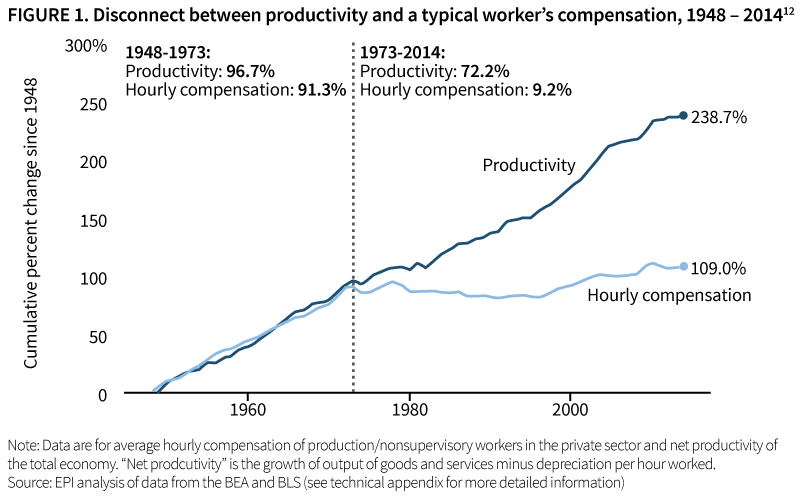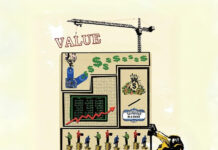Despite enabling widespread automation of routine tasks, mechanical technologies have created many more job opportunities than they have replaced in our Industrial Age past. How will the rapid progress of digital technologies affect work in our Information Age future?
It is axiomatic to say that everything is changing in the world of work. For many, these are exciting times with much to look forward to as we develop new technologies and capabilities to make our world a better place. The information revolution has brought many surprising – even disruptive – and positive benefits. Knowledge is abundant and more readily accessible than at any time in our past. Complex and clever supply chains deliver simultaneous choice, convenience and value for money for consumers. Platform technology has turned established industries upside down, creating exciting opportunities and challenges for innovation: “Uber, the world’s largest taxi company, owns no vehicles. Facebook, the world’s most popular media owner, creates no content. Alibaba, the most valuable retailer, has no inventory. And Airbnb, the world’s largest accommodation provider, owns no real estate. Something interesting is happening”.1 Visions of our work future are similarly bold. Optimistic futurists predict the demise of the nine to five grind. Work in the future, they say, will be highly discretionary, with folk working on what they want, how they want and when they want. Vertical career progression up the corporate greasy pole will be replaced by portfolio working, with versatile individuals developing their own do-it-yourself career packages of complementary roles in multiple overlapping networks. This is a bright future of strong personal brand, constantly interesting work, instant results (and perhaps gratification), global connectivity and positive (and ceaseless) progress.
For others, it is a potentially scary future of high personal uncertainty. The economist, John Maynard Keynes, issued a cautionary note in the 1920s about the risk of “technological unemployment”.2 Echoing the fears that stoked the Luddite riots a hundred years earlier, Keynes envisaged a scenario in which advancing industrial technology would supersede the productive capabilities of humans for routine manual “blue collar” work (faster than alternative forms of employment could be found). One hundred years later, technological unemployment remains an uncomfortable prospect as digital technology advances to supersede potentially the cognitive capabilities of humans for “white collar” and professional work. A study by the Oxford Martin School forecasts that forty-seven percent of occupational categories, including accountancy, legal work and technical writing, are at risk of being automated within two decades.3
Technology is also indirectly transforming work by irrevocably changing the marketplace for goods and services. To better respond to intense competition and free market forces, employers will likely continue to seek greater flexibility of employment for all sections of the workforce. According to the United Kingdom (UK) Office of National Statistics, 2.4% of the UK adult working population was employed on zero hours contracts in 2015, an increase of 19% over 2014.4 Very few expect a job for life in the 21st century, but will it become the new normal in future to have no job at all?
However, there are strong reasons for optimism when considering the future of work. Past experience shows that technology has cumulatively created many more employment opportunities than it has eroded in our history.5 We need to understand the changing context of the world of work if we are to consider the world-scale political, economic, social and technological consequences for economies, organisations and individuals.
Our Industrial Past
How we work today has strong roots in the organising logic of 19th century Western Europe and early 20th century United States. The later stage of the European Industrial Revolution (and early US) was a period of explosive growth and radical transformation of the economic, social, political and technological circumstances of entire nations. The order of the day for the burgeoning business class was to create surplus economic value by maximising economies of scale in the production of goods. What were previously craft industries grew very large very rapidly. Industrial centres became established cities by vacuuming up workers from rural areas in a process of breakneck urbanisation to provide labour for factories. Many British communities remain built around the labour demands of declining or now non-existent industries, whether steel in Sheffield, coal in Durham or soap in Port Sunlight. In Britain and the USA, this revolutionary period was the crucible from which the business magnate, the corporation, the career manager, and the management consultant all emerged. This was the start of the era of big business and “professional” management.
Operating at scale became a key management challenge, as businesses grew large by creating markets for affordable products previously out of reach of the majority of consumers. Mass production fuelled mass consumption, and vice versa. Maximising productivity and lowering costs was made possible by simplifying work to the point where literally anybody could perform it. The abundance of labour for simple and routine work provided businesses with the wage flexibility to employ workers en masse at a predictable cost. Colonialism, and more recently globalisation, exported these principles of industrial work organisation across the world to make them a global phenomenon.
The Machine Bureaucracy
Much like the industrial technologies they relied upon, organisations came to be thought of as machines, to be rationally designed and managed as if an engineering problem. Rationalist organisational design was reflected in the principles of the ideal-type bureaucracy described, most famously – and ambivalently – by German sociologist, Maximilian Weber. To be as technically efficient as possible, work in the ideal-type bureaucracy was divided into specialist tasks (i.e. a high division of labour); performed as an official duty for which individuals were paid a wage (i.e. employment); with authority conferred upon an “office” or a position, and not a person (i.e. managers); and governed through an escalating hierarchy of authority (i.e. seniority); and in which staff and customers were treated uniformly and impersonally (i.e. no personal exceptions, whether for promotion or product). By organising work according to these principles, management (not owners or workers) were able to control productivity with great precision. This was key to growth and competitiveness: the most effective enterprises were those that could best match predictable demand for goods and services with predictability of supply in terms of volume, quality and cost.
Accompanying the technological revolution was a revolution in managerial technique. Task simplification lent itself to systematic and impersonal measurement; by performing highly detailed time and motion studies, managers were able to quantify almost every aspect of work performance and establish norms and benchmarks against which all employees were appraised as standard. Performance against established norms was tied explicitly to financial rewards (and penalties), with work becoming, inevitably, routine, transactional and intense. Workers who were able to perform the same simple routine task faster than their peers were rewarded financially. Experimental time, motion and measurement studies of worker output performed in the early twentieth century by the prototypical management consultant, F.W. Taylor, grew to become a recognised scientific discipline – management science – through which managers could optimise and objectively prescribe performance, independent of the thoughts and feelings of those performing the work. There was a clear pay-off in terms of efficiency. Consider Ford, arguably the most innovative company of its time. In 1908, when the Model T was introduced, Ford was capable of producing twenty seven cars per day. By 1923, factory output exceeded an astonishing two thousand cars per day due to continuous improvement of management technique and the introduction of the rolling production line.
Limitations to Efficiency
For the all the economic benefits, there were fierce critics of the social and political ramifications of these new ways of working. Many, including Marx famously, railed against the apparent separation between individuals and the fruits of their labour – an inevitable result of the capitalist mode of production referred to as “alienation”. The relative disempowerment of labour within the employment relationship precipitated industrial conflict on a scale to match the times. Labour movements across the industrial(ising) world were formed in exactly these circumstances in the late nineteenth and early twentieth centuries. Workers organised collectively in an attempt to match the considerable wage bargaining power of their employers. As individuals, workers were simply cogs in the cold, hard, and ruthlessly efficient logic of the machine bureaucracy geared solely towards the fulfilment of managerial goals and the creation of economic surplus. For customers there were limitations too. Whilst more affordable than ever before, mass-produced products were highly standardised, and typically as simple as the methods used to produce them. As Henry Ford famously remarked: “Any customer can have a car painted any colour that he wants so long as it is black.” Production was supply and not demand-led, with the customer occupying a position at the end of a very long and hierarchically managed supply chain.
But that’s all changed. Today’s environment requires organisations to respond rapidly to the multifarious and changing preferences of fickle customers – not something the bureaucracy was ever designed to accommodate. So what’s the alternative?
“The Future of Work Is Uber”. Discuss.
“Post-bureaucracy” is the not-so-catchy catchall term used to describe idealised principles for organising work in the dawning Information Age.6 More popular terms, no less buzz-wordy, include the “adhocracy”, organic (as opposed to mechanistic) organisation, the network organisation and, most flashy of all, the human cloud. All of these conceptions share a number of common traits – and choices for leaders – radically different to the Industrial Age logic of the machine bureaucracy.
Strategy and Decision Making in Future
A growing (and glowing) consensus from optimists casts a vision in which hierarchies are replaced by flat networks of highly connected and versatile actors (or nodes), each in possession of complementary capability and knowledge. When integrated, the whole of the network is far more valuable than the mere sum of its parts, with significant value residing in the connections. In place of the traditional boundary between internal and external actors, the boundary of the “post-bureaucratic” network organisation is fuzzy. The distinction between internal and external becomes less meaningful in the “open system” of the organisation, as knowledge pours in from multiple sources and fuels innovations. Knowledge is shared widely across the entire network and flows in all directions to wherever it is required.
The bureaucracy was characterised by formal planning made in advance of implementation, and enforced by impersonal rules, policies and procedures devised by management. Strategy in the post-bureaucracy is emergent in nature, perhaps reflecting what Henry Mintzberg described as mere “patterns in a stream of decisions”.7 Moreover, it is predicted that decisions will reflect the collective-will of the whole of the informed network, as opposed to the judgement of a few individuals at the top of a hierarchy. The democratisation of decision-making requires that information be shared freely throughout the network to permit members to reflect meaningfully on the collective wellbeing of the whole enterprise, and not simply their own individual area or interests.
Social and Digital Connectivity in Future
To mobilise its collective wisdom to address complex problems and new discoveries, the network relies upon a web of weak and strong relationships. Strong relationships involve a degree of interdependence between network actors, such as mutual accountability for the completion of a shared task. Weak relationships might simply extend to spontaneous knowledge sharing. Nevertheless, all relationships are valuable forms of social capital through which the network is enriched and made resilient. Informal relationships allow the organisation to configure and reconfigure rapidly to best fit its changing circumstances (e.g. changing customer preferences or environmental disruption). Whereas economies of scale characterised the organising logic of the machine bureaucracy, economies of association will determine strategic value in this conception of the future organisation. Maximising the potential for sustained distinctiveness in the marketplace by constantly reinventing work will be the top priority for custodians of the network overall.
The relationship between human capital (people) and technological capital (machines) will cease to be that of master and servant. In a reversal of roles, significant aspects of work performed by people will be dictated by machine intelligence. Moreover, humans will lose their monopoly on the creative process. According to the United States Air Force, machines will contribute more and more to innovation capability. Where tasks are not delegated entirely to capable machines, machines will augment the performance of their human counterparts as man and machine become closely coupled to cope with the “enormous data volumes, processing capabilities, and decision speeds that technologies either offer or demand.”8
Freelance and T-Shaped Talent in Future
Human capital in the post-bureaucracy will be split into two main categories between which individuals will likely switch according to circumstances – network custodians and performers. Network custodians will primarily invest their time in maintaining the health and vitality of the network. They will work to secure the requisite variety of expertise and knowledge necessary for the network to respond to complexity, challenge and opportunity within its environment. They will also serve to reinforce and enrich existing connections between network members whilst also establishing new connections for both expressed and opportunistic purposes. To succeed in the knowledge rich network environment, network custodians will need to become “T-shaped”, capable of developing a depth of specialist expertise in a relevant field, but retaining general knowledge of other fields so that valuable connections and new combinations of knowledge might be forged.
Performers will focus on the completion of a specific task aligned to the common aims of the network. Tasks may be narrow or broad in scope, short or long term in horizon and flexibly sourced. For example, platform principles are already being applied to match individuals (labour supply) to work opportunities (labour demand). Amazon’s Mechanical Turk is one such platform, connecting prospective “requesters” (aka employers) to over 500,000 “taskers” in over 150 countries. As matching becomes more efficient, and less risky, expect to see casual relationships between organisations and freelance talent blossom, even for complex and high value roles.9
Many of these developments are countercultural in the contemporary workplace. Consider Master of Business Administration (MBA) degrees. The first MBA was created at the Wharton School of Management at the University of Pennsylvania in the late 19th century for the expressed purpose of training a cadre of professional administrators (hence the name) to service the needs of the bureaucracy. T-Shaped talent will require a holistic education in the interrelatedness of many different subjects. Successful network relationship brokers will be polymaths (i.e. know a little about a lot of things) necessarily to make novel and high potential connections between individuals and groups with potentially similar interests but dissimilar backgrounds. Thinking horizontally about career progression runs contrary to the functional (and specialist by definition) demands of established vertically oriented careers. Will moving sideways satisfy the ambitions of fee paying MBA students as much as moving upwards?
Mutuality of Means and Ends
The bureaucracy presumed workers to have different interests to those of their employers – simplistically, employers wanted workers to work as hard as possible for the least amount of pay, and workers the opposite. Aligning staff to the goals of their employing organisation was achieved by enforcing strict rules, setting precise targets and offering financial incentives to perform. Those same controls would be entirely counterproductive in the future workplace. They would limit the ability of the organisation to change rapidly by harnessing the discretionary effort and self-directed creativity of its people. Motivation will be primarily intrinsic in future, appealing to the emotive aspect of the work relationship and the fulfilment of shared purpose. In the absence of discernible superiors, performance management will likely be peer to peer. Reputation will never have mattered more for individuals and for entire networks.
A number of high profile firms are abandoning established performance management systems in favour of a more holistic and data driven approach to improving workplace collaboration, discretionary effort and enterprise-level thinking. For example, Deloitte has made well publicised changes to the way in which it assesses performance, breaking its industry norm: “We’ve arrived at a very different and much simpler design for managing people’s performance. Its hallmarks are speed, agility, one-size-fits-one, and constant learning, and it’s underpinned by a new way of collecting reliable performance data.”10
Network Thinking and Collective Outcomes
 The complexity and dynamism of the marketplace will require wisdom beyond the capability of any few individuals sitting atop an organisational hierarchy, no matter how “heroic” or wise. Post-bureaucratic organisations in future will represent collectives in which individual interests are subordinate to community interests and ideas are crowd sourced. The explicit purpose of the organisation will represent a higher purpose for all. Individuals and groups will willingly be a means to the organisation’s ends because its purpose defines their own. Gary Hamel said of creating superior engagement for vital talent, “create a cause and not a business.” Businesses in future will feel more like causes for which there is genuine passion, rather than an impersonal and purely functional employment transaction between capital and labour. Causes speak to the emotive power of purpose as the unifying force behind the future of work – mutuality, unity and shared identity.
The complexity and dynamism of the marketplace will require wisdom beyond the capability of any few individuals sitting atop an organisational hierarchy, no matter how “heroic” or wise. Post-bureaucratic organisations in future will represent collectives in which individual interests are subordinate to community interests and ideas are crowd sourced. The explicit purpose of the organisation will represent a higher purpose for all. Individuals and groups will willingly be a means to the organisation’s ends because its purpose defines their own. Gary Hamel said of creating superior engagement for vital talent, “create a cause and not a business.” Businesses in future will feel more like causes for which there is genuine passion, rather than an impersonal and purely functional employment transaction between capital and labour. Causes speak to the emotive power of purpose as the unifying force behind the future of work – mutuality, unity and shared identity.
The Likely Reality of Something in Between
The list of likely attributes of the future workplace could go on and on. If only a few of these developments come to pass, how we work in our Information Age future will indeed be very different to our Industrial Age past. We can see many aspects of the envisaged future workplace today. Collaboration, employee empowerment, emotional intelligence, culture management and so on are commonplace business practices today. They are all post-bureaucratic in nature. They are decades old concepts implemented by firms to address the perceived shortcomings of the bureaucracy.
However, it would be wrong to abandon our industrial age thinking completely. Efficiency will continue to matter as much as ever in future. Bureaucratic ways of working will always be the most appropriate way of producing the indispensable commoditised products we consume on a daily basis. The challenge for organisations and leaders in the 21st century is to become ambidextrous – capable of being simultaneously efficient at exploiting existing opportunities, and exploring what capabilities are required for competitiveness in future.
To be ambidextrous, organisations may well come to resemble networks more than hierarchies – especially when viewed at the enterprise level. However, within these networks there will be elements that are organised bureaucratically. The principles of a division of labour, supervision, impersonal rules and formalisation of work practices will always have a place in the world of work, whether performed by man or machine. The networked Enterprise Ecosystem will provide the umbrella for multiple different species of sub-organisation, with work organised either bureaucratically, post-bureaucratically, or any point in between, according to requirements. The work challenge in future is therefore to be both efficient and innovative.11
Questions to Ponder and Potential Consequences
There are winners and losers in all change. What might the future of work envisaged in this article mean for economies, organisations and individuals? There are many more questions than there are answers.
For instance, will everybody benefit equally from the shift from bureaucratic to post-bureaucratic ways of working? Wage inequality is a political hot potato. Many commentators see the United Kingdom’s vote to leave the European Union in a referendum on the 23rd June 2016 – the so-called “Brexit” – as a backlash against the perceived ill effects of globalisation, post-industrial economic stagnation and immigration (and low skill migrant labour especially) by Britain’s most economically vulnerable communities. Similarly, support for Donald Trump in the US presidential election on the 8th November 2016 was strongest amongst rust-belt working communities hit hardest by the decline in US manufacturing. Figure 1 illustrates the stark disconnect in the US from the 1970s onwards between stagnating workers’ wages and productivity. For decades, the “typical worker” has not shared in productivity gains accrued through the opening up of global markets or the introduction of new technologies. Why wouldn’t communities that feel left behind vote to change the status quo?
Is work set to become even more unequal in our digital future? How many will thrive in the future workplace or fall by the wayside? What are the social implications of changes to employment? What new assumptions will we need to adopt to reflect the new reality of life, liberty and the pursuit of happiness through work? Can we, or should we, even try to sustain those who cannot or will not change with the times?
For all of the opportunities the future of work must surely present, how will organisations manage the increased complexity of network working when stripped of tried and tested structures? How will firms continue to generate loyalty and commitment amongst people they rely upon to perform vital work, but don’t employ? Who is to blame when things go wrong? Where does accountability reside? What does good look like? Who decides? Who is in charge when no one can decide?
How will individuals plan for the future if the future is inherently uncertain? Is the unavoidable counterweight to increased job flexibility, such as the ability to work at one’s own discretion, decreased job security? How should we educate our children to thrive in a post-bureaucratic world? Mastering technology is perhaps the easy part. How can we give them the best chance of developing the self-awareness and sociability to meaningfully connect with others across the unstructured landscape of the human cloud? Are we all to become entrepreneurs of our own personal corporation of one? Will we be left bereft by the absence of established career paths and easy choices that we currently take for granted? With choice comes consequence. As individuals, do we really want to be left to our own devices completely? Is it even a choice?
About the Author
 Jonathan Trevor is Associate Professor of Management Practice at Oxford Saïd Business School, University of Oxford. Jonathan’s principal research, teaching and consulting interests are the linkage between strategic and organisational priorities (people, structures, systems and culture) and the development of capabilities that give organisations a distinctive competitive edge.
Jonathan Trevor is Associate Professor of Management Practice at Oxford Saïd Business School, University of Oxford. Jonathan’s principal research, teaching and consulting interests are the linkage between strategic and organisational priorities (people, structures, systems and culture) and the development of capabilities that give organisations a distinctive competitive edge.
References
1. Tom Goodwin, Crunch Network, 2015: http://techcrunch.com/2015/03/03/in-the-age-of-disintermediation-the-battle-is-all-for-the-customer-interface/#.qwngvf2:0sCd
2. John Maynard Keynes, Essays in Persuasion, New York: W.W.Norton & Co., 1963, pp. 358-373.
3. Frey, C.B. and Osborne, M.A., 2013. The future of employment: how susceptible are jobs to computerisation. Retrieved September, 7, p.2013.
4. http://www.ons.gov.uk/ons/rel/lmac/contracts-with-no-guaranteed-hours/employee-contracts-that-do-not-guarantee-a-minimum-number-of-hours–2015-update-/employee-contracts-that-do-not-guarantee-a-minimum-number-of-hours–2015-update.html#tab-conclusions
5. http://www.economist.com/news/briefing/21594264-previous-technological-innovation-has-always-delivered-more-long-run-employment-not-less
6. Heckscher, Charles, C. Heckscher, and A. Donnellon. “Defining the post-bureaucratic type”. (1994): 14-62.
7. Mintzberg, Henry. “Patterns in strategy formation”. Management science 24.9 (1978): 934-948.
8. United States Air Force Chief Scientist (AF/ST) as Report on Technology Horizons: A Vision for Air Force Science & Technology during 2010–2030 Volume 1AF/ST-TR-10-01-PR, September 2011
9. www.nytimes.com/2007/03/25/business/yourmoney/25Stream.html?ex=1332475200&en=cd1ce5cc4ee647d5&ei=5090&partner=rssuserland&emc=rss&_r=0
10. Buckingham, M. & Goodall, A., (2015), “Reinventing Performance Management”, Harvard Business Review, April
11. Gibson, C. & Birkinshaw, J. (2004), “The Antecedents, Consequences, and Mediating Role of Organizational Ambidexterity”, Academy of Management Journal, 47:2 209-226; doi:10.2307/20159573
12. http://www.epi.org/productivity-pay-gap/




































